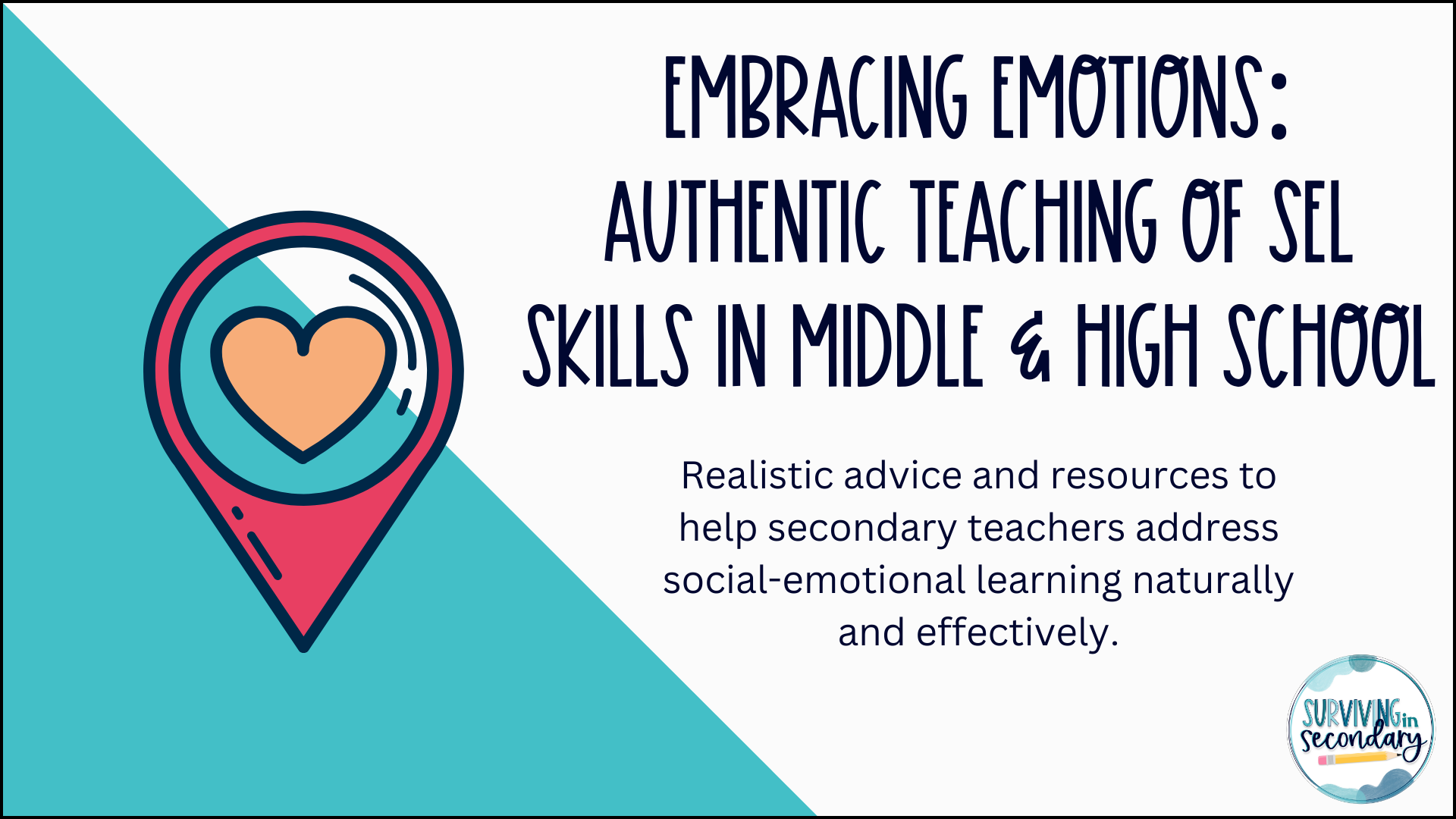Embracing Emotions: Authentically Teaching SEL Skills

By Kasi @ Surviving in Secondary
Let’s be real — “don’t let them see you smile until December” is awful advice, no matter how many people claim it as “words of wisdom” for new teachers. You aren’t a robot, and honestly, why would you want anyone to think that you are? How is a stoic face supporting student growth on any level when they are still learning how to express themselves in an appropriate manner? Now, I'm not suggesting that you need to smile every waking minute in your classroom — that’s equally unrealistic. What I’m suggesting is that being a professional human in the classroom includes showing a range of emotions, from happy, sad, confused, excited and even…dysregulated.
Being a classroom teacher, especially in an emotional support program, I have experienced many of the high and lows of the emotional roller coaster that is teenagehood. These moments tend to happen right in the middle of teaching slope-intercept form or while discussing symbiotic relationships. During these moments, it’s easy for the dysregulation to take charge of the environment and uproot a perfectly good academic lesson. Don’t allow this moment to run away from you, use it. That’s right — use it. These on-the-spot teaching moments can be some of the most impactful, so take advantage of the opportunity and transform the academic lesson into a behavioral one by modeling the behavior you wish to see when one emotion is taking too much control.
Modeling self-regulation coping skills, such as breathing exercises, to middle and high school students can have numerous benefits. When educators demonstrate these techniques in a calm and confident manner, they provide students with a tangible example of how to manage stress and regulate their emotions effectively. This modeling not only teaches specific coping skills but also reinforces the idea that it is normal and healthy to experience stress or strong emotions. Additionally, seeing adults use these techniques can help students feel more comfortable and motivated to try them out themselves, leading to improved emotional well-being and academic performance.
Using natural environment moments to teach self-regulation to middle and high school students can be a powerful strategy for fostering emotional intelligence and coping skills. Instead of hiding how you are feeling, I suggest you use it as a tool to teach others and model a regulation strategy. What do I mean by this? Well, a few weeks ago the class asked me to play an online review game with them, and I agreed. My students know that I enjoy playing these games with them, and although I often lose, I’m competitive enough that I get into it with them. So, a few weeks ago, I lost, and, after congratulating the victor, we needed to transition to our next class, math. Now, our game got intense and fun. None of us wanted to do math two minutes later, but that was the expectation. So, I put up the math warm-up on the board and prompted everyone to grab their math warm-up paper. Everyone was still talking and giggling about the game, which questions they got right or wrong, and who stole what coins from each other…basically, everyone was off-task and unfocused.
I saw this happening and, instead of focusing on the academic demand I placed on them, I embraced the natural cue to practice self-regulation. In front of the room, I took a couple of deep breaths and verbalized, “whoa, I’m not focused. That game was fun! But it has me all amped up, and I need to relax a little and focus.” I then walked over to my desk and took out my rainbow block fidget. As I rolled it around in my hand and walked back to the board, my students were watching. Now, of course, someone asked for my fidget. I replied, “Maybe when I’m done, but I’m using it right now so I can regulate how I’m feeling and get ready to teach math — it’s what helps me.” At this point, I was calm and ready, and I saw my class slowly getting to the same place. I took a few more deep breaths so they could see me practicing the techniques we’ve been teaching them, and then I got started on reading the math warm-up out loud.
This was a small moment in my classroom. It lasted maybe 3-5 minutes. But its impact is much longer. Instead of fighting against my students’ (and my own!) emotions to teach the academic standard of the day, I harnessed that teachable moment and modeled a perfectly acceptable strategy to bring myself back to regulation. I practiced what I preached, instead of preaching without practice, and my classroom is more regulated for it. Need some support in doing the same? Use this Road to Resilience Inventory to help students identify their own triggers and coping strategies that work best for them!
At the end of the day, I’m not a robot. I’m focused on supporting the next generation to become productive members of society and be the best versions of themselves. That includes how they treat others and how they treat themselves. By modeling self-regulation coping skills, educators not only equip students with tools for personal success but also contribute to building a more empathetic and compassionate society. Ultimately, the goal is to empower students to navigate life's challenges with resilience and empathy, shaping them into individuals who are not only successful in their endeavors but also kind and considerate in their interactions with others.
If you are looking for some more resources to provide your students with social-emotional learning practice, especially for those days leading up to spring break, we suggest a fun movie experience with this SEL BINGO or Tic-Tac-Toe Board!
Here's to surviving and thriving!
Let's stay in touch! Sign up here to join our email list (and maybe even snag a freebie)!!
Thank you for subscribing!
We'll see ya in your inbox soon!
